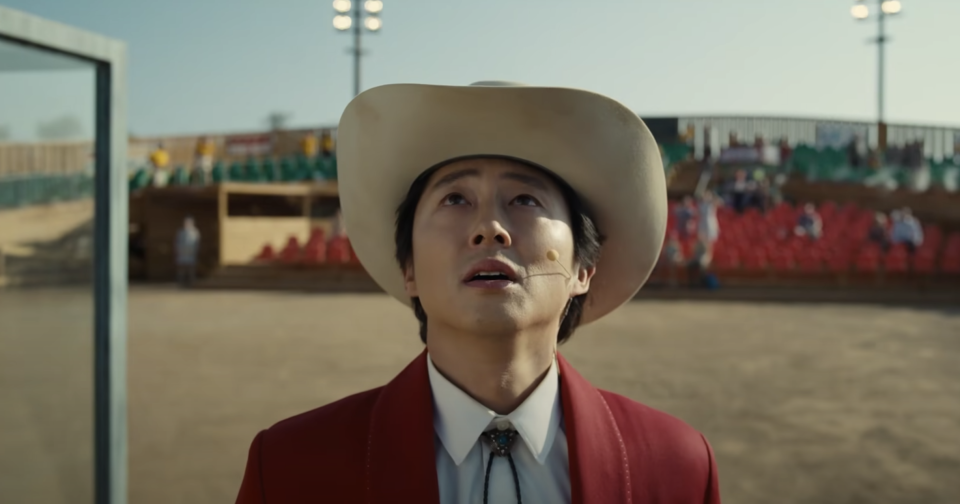Welcome to Jupiter’s Claim: Building the Old West Town at the Center of ‘Nope’

- Oops!Something went wrong.Please try again later.
- Oops!Something went wrong.Please try again later.
No one can accuse writer-director Jordan Peele of resting on his laurels. In his third directorial effort, “Nope,” Peele takes as big a leap forward in terms of ambition and audacity as he did from “Get Out” to “Us,” remaining as personal, obsessive, and idiosyncratic as ever in his interests but exploring his preoccupations across a more expansive canvas. “Nope” is both a nerve-shredding sci-fi horror film and a wry, multi-faceted satire, a spectacle about spectacle that delivers the satisfactions of the summer tentpole movie while asking why we crave those satisfactions — and what it costs the people who manufacture them.
By populating his sci-fi epic with characters operating on the margins of show business — a financially strapped horse trainer (Daniel Kaluuya), his attention-hungry sister (Keke Palmer), a grown-up child actor with a traumatic past (Steven Yeun), and a past his prime cinematographer (Michael Wincott) — Peele is able to pull back the curtain on the casualties of Hollywood magic even as he dazzles the audience with some pretty impressive magic of his own.
More from IndieWire
The central metaphor for Peele’s exploration of the intersection between entertainment, capitalism, and exploitation is Jupiter’s Claim, a California Gold Rush theme park run by Yeun’s character that is, like “Nope” as a whole, inviting and threatening in equal measures. (It will also be the first set ever to be added to Universal Studios’ backlot tour on the same day as the movie’s release.)
Awe-inspiring in both its size and its attention to detail, the attraction was invented from scratch by production designer Ruth De Jong, reuniting with Peele after their work together on “Us” (a film with a very different sort of horrific amusement park at its center). “When we started, the desire for Jordan and I was to find an existing Western town,” De Jong told IndieWire, “but it needed to be hyper-stylized and ridiculous, so we quickly realized we had to build it from the ground up.”
Once De Jong and Peele had the necessary conversations with the producers and studio about what this would mean in terms of budget, the production designer immersed herself in a study of Old West attractions across California, Montana, Nevada, and Arizona while also referencing everything from movies like “Heaven’s Gate” and “Once Upon a Time in the West” to ’70s television shows that built their own towns. As with every other element of “Nope,” there was a fine line between paying homage to the traditions of the genre and subverting those traditions. “Jupiter’s Claim was supposed to be a play on the Wild West and the American dream,” De Jong said. “It’s this little Podunk town, but to [Steven Yeun’s character] Jupe it’s a true spectacle.”

screenshot
De Jong’s design operates on these two levels brilliantly, managing to convey both the pervasive kitsch that is the park’s reality and the sense of wonder that Jupe sees it with and aspires to transmit to his customers. De Jong began with the bones of a traditional frontier setting — general store, bank, saloon, etc. — to orient the audience, but the skin and muscles of the set are wild colors and adjustments in scale that make it what the production designer called “a Western town on acid.” Grounding the park was essential to De Jong so that once the movie’s more fantastical elements came into the story, the audience would already be well past questioning their plausibility. “I never want people to think, ‘Oh, that’s a set,’” she said.
One way that De Jong made sure her sets would be convincing was to give them all practical interiors and connect key locations geographically without cheating. Each part of Jupiter’s Claim is connected and functional, and the theme park itself is in close proximity to the film’s other key location, the family ranch where Kaluuya’s character lives.
De Jong credited location manager Justin Duncan with finding a piece of property surrounded by foothills and mountains where both the Haywood ranch and Jupiter’s Claim could be physically linked as well as particularly vulnerable to alien threats from above. “Jordan wants it to be iconic and breathtaking and so many other things, but he also wants you to believe his stories could really happen. I want that too, and I think that’s why we get along so well.”
Universal Pictures will release “Nope” in theaters on Friday, July 22.
Best of IndieWire
From 'Barbie' to 'Babylon,' Here's Everything Margot Robbie Has in the Works
All the Details on 'Hunger Games' Prequel 'The Ballad of Songbirds and Snakes'
Sign up for Indiewire's Newsletter. For the latest news, follow us on Facebook, Twitter, and Instagram.

